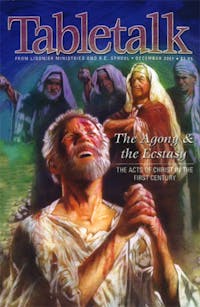
Request your free, three-month trial to Tabletalk magazine. You’ll receive the print issue monthly and gain immediate digital access to decades of archives. This trial is risk-free. No credit card required.
Try Tabletalk NowAlready receive Tabletalk magazine every month?
Verify your email address to gain unlimited access.
It is not uncommon to hear modern Christians say that they attend a New Testament church. Making all due allowances for what they might mean, my first impulse is to ask something along the lines of “Why would you want to do that?” Drunkenness at the Lord’s Supper? Controversies about bacon, idolatry, and circumcision? Of course, if the one making the statement simply intends to affirm sola Scriptura, then there is nothing exceptional about the sentiment—although he would do well to include the Old Testament. But the water is usually far deeper than this.
A set of romantic assumptions about revelation and history drives this sentiment. In this view, the church in the first century was pure, well-governed, and mature, and it was only as the apostles started to die off that corruptions started to flood in. In this we see the typical evangelical assumption about church history: There was a Golden Age lasting from one hundred to three hundred years, then a thousand years or more of darkness.
Now all heirs of the Reformation acknowledge that corruptions of doctrine and practice did in fact occur—otherwise, why have a Reformation at all?—but the classical Protestant position places the real trouble much later, and sees it as a very gradual process that infected some portions of the church far more than others. For instance, we know that wonderful things were happening in the court of Charlemagne, and through the high Middle Ages we find faithful saints laboring in the work of the Gospel. Dissatisfaction with the way some things were going is what made the Reformation happen—a movement from within the church to reform that same church. Now this takes us back to the first century. Our views on that century are a good litmus test for modern Christians. One view is that the modern church is a restoration—the original church all but disappeared, but God has brought it back. This restorationist mindset sees the work of God on this continent in the past two centuries as God starting over. When the question is asked, “Where was your church before (insert the date of your denomination’s founding)?” the usual answer is “The first century.” But the classical Protestant, when asked where his church was before the Reformation, replies by asking, “Where was your face before you washed it?”
The contrast is between a view of history that sees leaven working through the loaf and a view that sees the kingdom of God coming in fits and starts. Under the latter view, because the first-century church was complete, what we have now must be complete. It is an all-or-nothing mentality. The former view sees room for development, regression, reformation, creedal advance, and so on. It is not perfectionistic. But the all-or-nothing assumption is perfectionistic, and this accounts for its defensive dogmatism about the most indefensible things.
Consider some problems with our forms of worship, with our traditions. Because of our a priori commitment to be “the New Testament church,” we tend to understand our practices anachronistically. Because of massive historical illiteracy, the first century is a blank screen on which we may project our notions of ecclesiastical spirituality. Thus it is that forms of worship invented on the Kentucky frontier are thought to have been the practices of Peter, James, and John. A chorus with three chords accompanied by a guitar seems far more spiritual, simple, plain, and godly than, say, a wall of pipes for an organ. And there are people who actually believe that the wine of the New Testament was grape juice through and through, and they think this because someone started insisting on grape juice somewhere in Missouri a little more than a century ago. But in the light of history, to insist that Paul served grape juice at the Lord’s Supper is as silly as maintaining that he wore a necktie.
Some forms of medieval church tradition did drift away from the standards set by Scripture in the first century, and this drifting was culpable and called for reformation. The Reformers rightly wanted to return ad fontes, “to the sources.” But the sources they appealed to were not limited to Scripture, although Scripture was the final and infallible norm. The Reformers were the finest patristic scholars in the Europe of their day, and they understood the faithful patterns the church had followed for centuries.
In contrast to this, rather than seeing our era in the light of revelation and subsequent history, we tend to place the Scriptures in one cultural context—ours—and read and interpret them accordingly. By the grace of God, many elements of the Gospel still have been read accurately. But in numerous other ways, our evangelical traditions are just plain silly, and this is because in many ways the last thing we would want to have is a first-century church.
